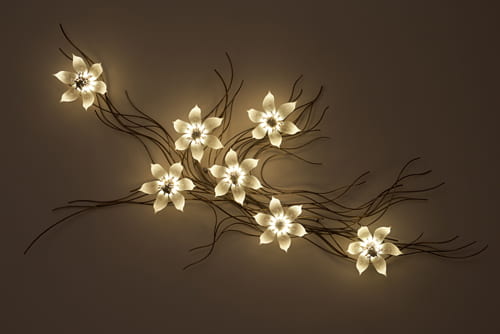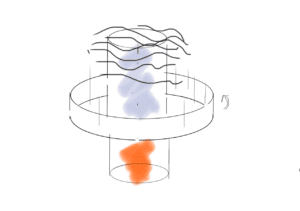Perspective & Context
Guy Brett approaches the concept of eye and body in his book by addressing that “the concentration on optic, the visual sense, as a vehicle for the exploration of movement and space/time, can be exploded, even from within visual are itself, by another tendency” (52). Such tendency, according to him, can be understood by and large as the separation of the visual form the other senses, or namely, the eye from the body. Through devices that “disturb, or manipulate, the body’s sense of space through a play the optic nerve”, kinetic art, allows for a “much more radical reorientation” of both out bodily experience and our thinking (52). In this sense, artworks by two contemporary artists, Esther Stocker and Sebastian Hempel, can be seen as various demonstrations of such concept of perceptual reorientation.

Esther Stocker creates spatial installations that manipulate people’s perception of space. Her ideas about space actually emerges from 2D paintings: in many of her words, the space are constantly reformed generated by perceiving lines or patched from different perspectives. In a reduced language of form consisting of black and white lines and grids, her works explore formal boundaries and spatial structures by creating a space where he viewer no longer can tell where the floor ends and the wall begins. Though her works are not kinetic, they demonstrate very well that the visual perception is a main factor for spatial experience.
Sebastian Hempel
The works of Sebastian Hempel are as full of movement as the spaces presented. While many of them are fitted with sensors, reacting to the presence of potential observers or users, who in turn trigger the artistic event by means of their body, there are also excellent works that concentrate on the motions with only installation. Those mechanical process have implications in terms of content, as all the aesthetic effects really on the motions of either installations or human movements. With a similar concept as Stocker’s work but demonstrate in a kinetic way, his kinetic light sculpture, Leuchtstabbild (Lightbarimage), really inspires me of the way space can be reformed with motions.
Project Description
Drawn from the concepts presented by these artists, I intend to build my project as an exploration of both motion and spatial experience. My project will be a kinetic collocation of lights which will function highly based on mechanic installation. I would have several light parts formed in based shapes like lines, squareness and grids with strip-lightings (tubes) . These parts would be place on/against a wall (by against I mean vertically) to create a combination of 2D/3D effect, and will be moving linearly in some order to generate the effect of reforming space.
To move the lights, I would build a mechanic installation with the idea of block and tackle. Each pull block will consist of motors, reels (maybe 3D printed) and strings. The movement for lights will be generative, and its order will be random for each lighting parts but synchronous as a whole, which will be achieve through Arduino programming.
Production Schedule (Three and a half weeks duration)
- 04/28 (Sun) Research & Material preparation
- 04/30 (Tue) Material & lighting test
- 05/02 (Thur) Physical part testing assemble (start by parts)
- 05/07 (Tus) Physical part testing assemble (finishing by parts, start installing)
- 05/09(Thur) Problem shooting
- 05/13 (Mon) Adjustment and finish installation
- 05/14 (Tue) Pre-Final Critique
- 05/15 (Wed) Final adjustment
- 05/16 (Thur) – Project 3 Presentation

























 The first artist that I look up to for constructing this project is Marcel Duchamp and specifically his work on the “Rotary Glass Plate”. Although this work embodied a simple motion in rotation, it really magnifies the sense of optical illusion from the drawing on the plate. It affects our brain magically that we sometimes forget about time because we are so deeply intrigued by it, which Ponty talks about in his perception writing. It could relate to many things in our lives too such as air current, plane turbine, etc. It is also these things that are related to time and space which is why it has the power to satisfy human curiosity in exploring space and the universe.
The first artist that I look up to for constructing this project is Marcel Duchamp and specifically his work on the “Rotary Glass Plate”. Although this work embodied a simple motion in rotation, it really magnifies the sense of optical illusion from the drawing on the plate. It affects our brain magically that we sometimes forget about time because we are so deeply intrigued by it, which Ponty talks about in his perception writing. It could relate to many things in our lives too such as air current, plane turbine, etc. It is also these things that are related to time and space which is why it has the power to satisfy human curiosity in exploring space and the universe.
